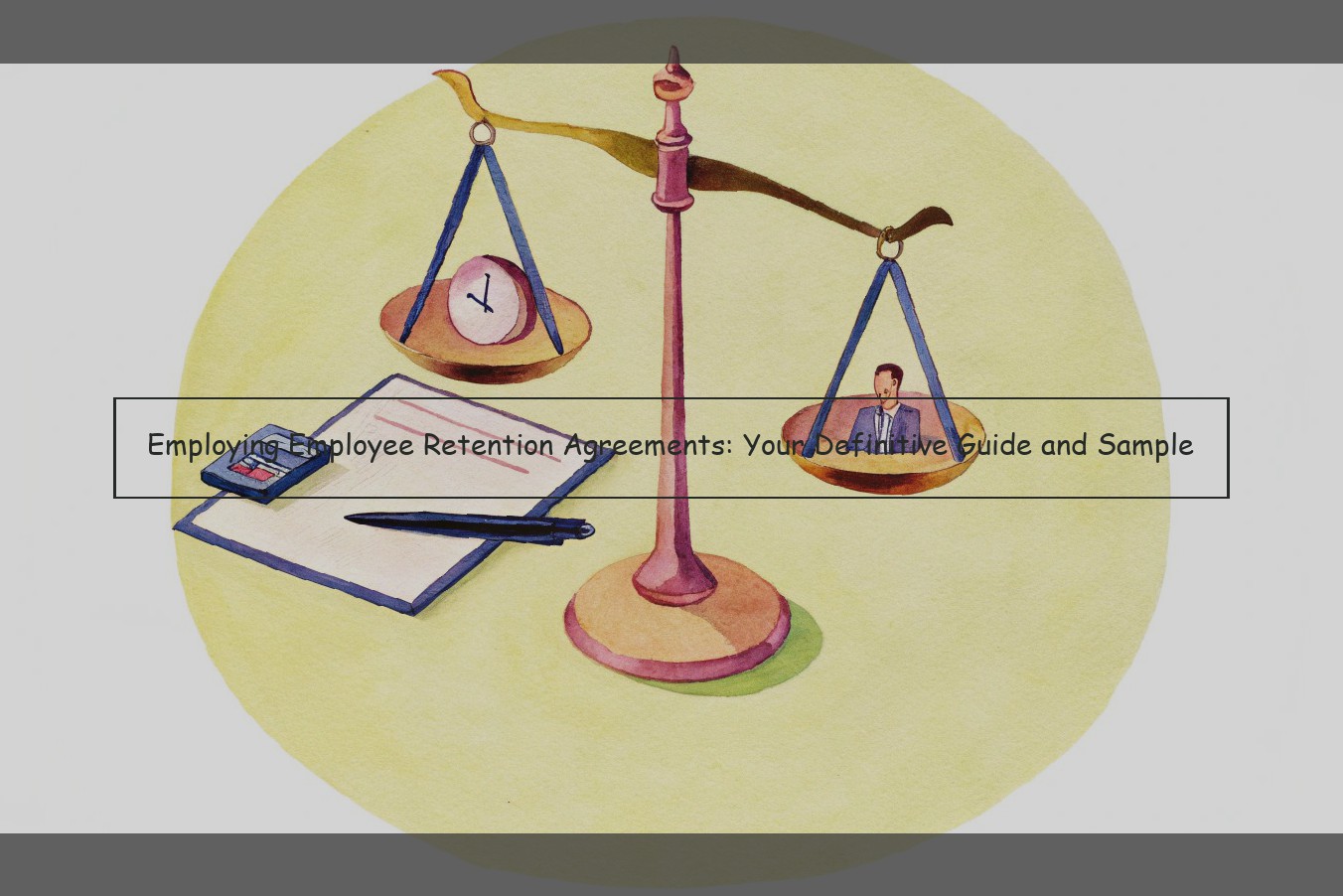Employee Retention Agreements Explained
Employee retention agreements have become a critical component of change of control agreements, merger agreements and asset purchase agreements. Their primary purpose is to keep key employees after a transition by acting as an incentive for the employees to remain in those instances when the employer no longer has the lucrative benefits of a change of control .
However, to be effective, the retention agreement must be drafted with an understanding of what a reasonable person would view as a benefit to them for continuing employment. If the retention agreement is too much of a financial disincentive, an employee may feel better leaving with their severance than remaining with the employer. If a change of control is desirable to an employee because of the potential for increased compensation, the cash/equity awards that are promised may need to be significant to convince them to remain.

The Must-Have Provisions for a Retention Agreement
While it may not seem like there is a standard retirement retention agreement, there are a number of key components that most agreements should and do contain, including the following:
Terms of Employment: A retention agreement should list the terms of employment for an employee so that he has minimal uncertainty about what will happen once he retires. This is important because a retention agreement is intended to provide an employee’s cash compensation and status once he has already retired.
Bonus Amounts: A number of companies will tie together the cash compensation that an employee receives with the amount of equity he retains in the company. For example, it is common to link the amount of a retention bonus to the number of shares that the employee retains after he is retired. The company can then agree to pay a retention bonus equal to the value of the retained equity at the time the employee retires based on the simplest equity valuation (i.e. the equity value at the time the employee stopped working with the company). The payment for cash compensation can then be tied to the amount of employee equity that the employee retains to keep the employee’s cash compensation as high as possible.
Vesting Schedule: The agreement will often set a vesting schedule for the equity that the employee keeps. It is also important to specify the conditions under which the employee can sell the securities, so that there is no chance that he would lose his bonus payment if he sells his securities to one of the other employees.
Conditions of Payment: The agreement should specify the conditions under which the company will pay the employee his bonus and when it will vest. A company can also specify that only "good leaver" provisions apply to the vesting of the bonus. Good leaver provisions explicitly prevent the retention bonus from vesting early or being accelerated if the employee is terminated for specific reasons, including wilful misconduct.
Tips for Drafting an Effective Retention Agreement
The process of drafting a retention agreement may seem straightforward, but there are some best practices to keep in mind to ensure that the agreement meets its intended purpose.
One of the most important steps in planning for a retention agreement is to understand the company’s goals. In doing so, it is essential to determine whether the retention agreement is intended to modify an existing contract, to be in lieu of a future employment contract, or to be a stand-alone agreement. Some retention agreements are drafted as free-standing agreements; others modify an existing employment agreement to extend the term of employment or modify other terms of the employment relationship.
Legal Compliance Depending on the structure and intent of the retention agreement, it may implicate several areas of statutory law. For example, if a retention agreement provides benefits or compensation upon separation from employment, the compensation may be considered severance pay under applicable state and federal wage and hour laws. Drafting these provisions with this in mind is important to ensure compliance with a patchwork of ever-changing state and federal wage and hour laws, including the portability of accrued paid time off and whether the law in question would require a payout of any such accrued time upon separation.
Severance agreements can also trigger obligations under the Older Workers Benefits Protection Act (OWBPA). A retention agreement that contains a release of claims in return for a retention award must satisfy the notice and waiver requirements of the OWBPA for a release to be legally effective. To that end, the agreement must provide the employee with a minimum of 21 days to consider the release (not counting the day of presentation of the agreement), the opportunity to work with an advisor of the employee’s choice in understanding the rights granted by the release, and a seven-day revocation period following the execution of the retention award.
In addition, Section 409A of the Internal Revenue Code applies to retention awards, such that the language of these agreements must be carefully crafted to avoid unintended consequences. However, coordinating the 409A requirements with the OWBPA requirements is a tricky business that requires balancing the top-level executive’s time requirements to negotiate and finalize a severance or retention agreement in the context of a corporate transaction with the 21-day consideration period for a valid release. Employers should keep in mind that these statutory requirements are not necessarily waived along with the employee’s claims through a release, so the employer remains liable for complying with these rules.
Clarity in Agreements It is important for the retention agreement to articulate, clearly and unambiguously, the employer’s intent and the purpose of the retention award. Care should be taken that the retention award is not viewed as a part of the employment contract or practice, but as a separate and distinct cash bonus type of payment. The retention agreement should make clear that the retention award will be reported as income for tax purposes, and that unless otherwise specified, the award is not intended to be part of the employer’s ongoing employment compensation and bonus program.
The retention agreement also ideally should be signed by the employee during the 21-day consideration period, and should note the date of signing and indicate that the employee has satisfied the 21-day consideration period and has voluntarily chosen to sign the agreement and desires to receive the retention award subject to the terms of the agreement.
Some employers undertake to provide independent legal advice to employees on the retention agreement to avoid later claims of duress, undue influence, and the like. To the extent this is done, it is advisable that the employer consider contributing toward the cost of such legal representation.
Customization and Flexibility Often, the retention agreement will need to be customized to the particular employee. For example, one employee may already be entitled to a certain amount of severance protection under an existing severance agreement, while another may have extensive change-in-control provisions in an existing employment agreement. In these instances, with respect to the employee with the existing severance agreement, the retention agreement should specify that the employee agrees to give up any rights to the existing severance or separate change-in-control protections, but in exchange receives the retention award in the amount that otherwise would have been due.
Conversely, for the employee with extensive change-in-control provisions, the retention award could allow the employer the flexibility to modify or enforce the change-in-control provisions with respect to that employee, depending on how the change-in-control provisions interact with the terms of the retention award. While the classic rule is that contractual rights cannot be modified without mutual consent, if the retention award is non-binding and intends only to act as a facilitation tool, the award arguably permits the employer to vary or modify existing contractual rights.
On occasion, companies may wish to use the retention award to funnel employees into post-employment restrictive covenants. In this regard, the retention award should provide that the employee is subject to the employer’s pre-established or future post-employment restrictive covenants and forfeits the retention award if he or she is found to be in violation of such restrictive covenants. In lieu of forfeiture, an employer may wish to provide the employee with the right to redeem the termination rights for a payment equal to a multiple of their base salary in place at the time of fraud or breach, and recoup the retention award.
Sample Employee Retention Agreement
In consideration for each other’s promises, the parties agree as follows:
The Company agrees:
The Employee agrees:
The Employee further agrees that he/she will forfeit the retention bonus payment if he/she voluntarily terminates employment with the Company before the payment is made by the Company.
The Company may require that the Employee return the retention bonus payment to the Company if the Employee voluntarily terminates his/her employment after the payment is made by the Company.
The Company may contract with a third party plan administrator to administer the retention bonus program . In the event that the Company does use a third party plan administrator, the Employee will establish an account with the plan administrator and complete all necessary documents for the plan administrator to directly deposit to the Employee’s account the retention bonus payment as specified in Article 2(a) above.
The Employee acknowledges and agrees that the Company may assign this Agreement to a continuing or successor employer, including assignability to an affiliate or subsidiary of the Company, by inclusion of a copy of this Agreement in any purchase or similar agreement. The Employee also acknowledges and agrees that such an assignment shall not be a "sale" or "transfer" of assets for purposes of any change in control language in any applicable plan, policy or severance agreement.
Essential Legal Considerations & Compliance
They may seem like a quick fix for a short-term problem, but employee retention agreements can be fraught with legal traps for the unwary.
One of the most basic standards for drafting is to ensure that the agreement is intended to be enforceable under all applicable laws. With a few notable exceptions, including Texas, Arizona, Maine and Louisiana, all states require that non-compete agreements satisfy a three-part test: (1) the agreement must be ancillary to a lawful purpose or contract; (2) the agreement must be limited in time, geographic scope and subject matter; and (3) the agreement may not impose any hardship on the public.
The second requirement for compliance is that the agreement you draft and implement must comport with the factual situation presented. In some cases, the agreement may address more than one position within the company. In other cases you may have one or two employees that are so critical to your operation as to warrant extra attention.
Moving along, be sure that the provisions of the agreement are not overbroad. For example, is the agreement drafted to prevent an employee from performing any work in a given industry for a number of years? That will not fly – it would likely be considered a restraint on time and geography and would run afoul of the majority of courts in all states except perhaps Arizona.
Theoretically, the offer of 2% of the company (assuming the company is worth $1M) would not be a restraint. But that’s theoretical and seems a bit far-fetched for an essential employee and you may want to consider whether the agreement would be compliant with a particular state’s statutes or case law.
Another issue with employee retention agreements is how to address termination of an employee prior to repayment of the loan. This should be addressed in a manner appropriate for your business.
While you will want to set forth the method (e.g. an interest-free loan for the 10% down) and the repayment schedule in the agreement (e.g. payment in full within 30 days after termination) there are a couple of issues to be aware of. First, the loan must be entirely re-paid within 24 months (i.e. the loan cannot extend out for 3 years). Also, the loan must be made in the same year as the sale of the disqualifying asset. In other words, don’t allow an employee to terminate under an employee retention agreement and continue making principal payments on a loan several years past the sale of the "disqualifying asset."
An often-overlooked issue in multi-owner businesses is the potential for competing interests among the owners. These potential conflicts can be avoided by putting together a plan that is agreed to by all of the owners. In addition, ensure that the agreement is drafted to protect the interests of other owners (i.e. the provision should be clear that if the deal goes south the loan is forgiven).
How to Get the Most from Your Retention Agreements
Retention agreements should contain a well-designed mix of financial and non-financial components. Financial elements can be the key to ensuring that the economic value of promised payments is maximized. Non-financial considerations are just as important, for a positive experience with a retention agreement is almost always a deciding factor as to whether a key employee will stay or join a competitor . For a retention agreement to have the desired motivational impact, communication is critical, both for individual fully-considered employee input and for the company’s broader explanation of its objectives in building a true partnership based on shared goals. It is also key to carefully review and assess the effectiveness of a retention agreement. When developing retention agreements, companies and executives should consider establishing milestones (for individual key employees) or general tracking criteria, based on the program’s goals, by which the success of a retention agreement can be periodically reviewed.



